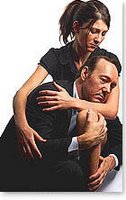Book Review: P.K.Dick - The Man in the High Castle
 Finished 30. October 2006
Finished 30. October 2006
By Philip K. Dick. Set in an alternate History U.S., in a world where Germany and Japan had won WWII.
As with most of the other PKD novels I have read Dick explores this setting from the perspective of minor everyday charaters - a shop keeper, a craftsman, his divorced wife - who get entangled with representatives of the victorios powers - a high ranking Japanese official, a German spy, another German spy. Through their interaction Dick explores a whole host of topics:
- The cultural assimilation process between conqueror and conquered
- Alternative approaches to decision making
- The possibilty of and possible interaction between different worlds
The cultural assimilation process between conqueror and conquered
The Japanese adore American history. High ranking Japanese collect historical artifcats - movie posters from before the war, antique firearms, Mickey Mouse watches. And around this a whole economy develops, including mass produced counterfeits, expensive specialist shops, collectors and fashions.
Alternative approaches to decision making
Both Japanese and conquered Americans are known to use the old Chinese I Ching when presented with crucial choices in their life. The application differs, from highly conscious reflections on the oracles given to thoughtless drifting and retroactive interpretation.
For some of the protagonist this starts to change to a more idependent visionary perception - triggered by artifacts created as a sub-conscious break-out of he by now superficial trade in historical artifacts.
The possibilty of and possible interaction between different worlds
In this alternative world a book is published, describing a history where Japan and Germany lost the war. Yet this book within the book does not necessarily depict our world. Yet, from the few glimpses we get of this third version of hisory, there seems to be at least one common denominators in all three world: The two vicorious powers enter a cold-war phase that inevitably leads to an attempt of gaining world dominance.
There is also some hint of PKD's more ususal SF settings: Rocket ships take only 45 minutes from Berlin to San Francisco, the Mars is being colonized, Venus explored. Yet these just help to highlight the difference, they never take center stage.
To quote the hype on the backcover of the Penguin Classics edition
'Dick's finest book, and one of the very best science fiction novels ever published'Couldn't agree more
Eric Brown
You can find more information at


